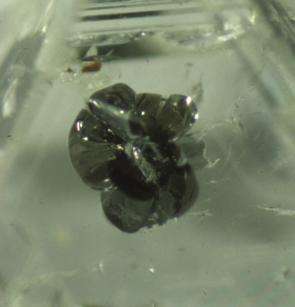Canadian diamonds found to be oldest on Earth

For the first time, scientists have dated diamonds from the recently discovered diamond fields in Canada’s Northwest Territories and have found them to be the oldest precisely dated diamonds on Earth. They formed 3.5 billion years ago in an era called the Archean when the Earth was forming its first continents.
Other ancient continents, such as in southern Africa or Siberia, have long been known to have diamonds almost as old, but none that have been so precisely dated.
The researchers, including Steven Shirey and Richard Carlson from the Carnegie Institution’s Department of Terrestrial Magnetism, Kalle Westerlund, Stephen Richardson, and John Gurney from the University of Cape Town, and Jeffrey Harris from the University of Glasgow, also report evidence suggesting that the diamonds formed during a process called subduction. Subduction occurs when one crustal plate sinks and slides under another and is plunged hundreds of miles into Earth’s mantle.
This conclusion documents one of the oldest known examples of modern plate tectonics. The findings are published in the September issue of Contributions to Mineralogy and Petrology.
“Diamonds aren’t just for spectacular jewelry,” commented Shirey. “They are scientific gems too. They act as tiny time capsules. Many diamonds encase tiny mineral grains—what jewelers call impurities but geoscientists call inclusions—that can tell us how old the diamond is and what geologic processes occurred in the deep Earth billions of years ago.”
Diamonds, dense forms of carbon, are the hardest natural substance known. The largest diamonds come from cratons—ancient continental regions and their deep roots that provided a nucleus around which younger continental material gathered. Cratons contain the oldest rocks on the planet and hold much of the Earth's mineral wealth, including diamonds. Cratonic roots extend into the mantle more than 125 miles (200 km) deep where pressure is high enough, but temperature cold enough, for diamond formation. The mantle “keels” to cratons are as old as the overlying crust and they date to the Archean period (3.9 to 2.5 billion years ago). Rare volcanic eruptions, of magmas that solidify into rocks called kimberlites, from depths of 95 to 125 miles (150 to 200 km) have brought diamonds to the surface as passive passengers in the exploding kimberlite magma.
Diamonds come in two major varieties: eclogitic and peridotitic. Scientists have believed for some time that eclogitic diamonds, related to the high pressure equivalents of basaltic crustal rocks, form from the process of subduction. But this study contains the first evidence that the peridotitic diamonds, which are in chemical equilibrium with the peridotite of the Earth’s mantle, also may be formed from the water and other fluids released by subducting crustal plates at depth.
The scientists extracted sulfide inclusions from a sample of diamonds, each about 1 carat in weight, excavated from Canada’s Slave Craton’s Panda kimberlite and determined their age with the rhenium-osmium (Re-Os) dating technique. Rhenium and osmium are natural radioactive isotopes. These isotopes decay at a predictable rate and make good atomic clocks for determining absolute ages. The Re-Os technique is especially useful for dating sulfide minerals packaged in diamonds because sulfides concentrate either Re or Os and hence have widely varying Os isotopic compositions that can be used to determine their age. Scientists can determine whether processes such as melt percolation, crustal recycling, or fluid addition contributed to sulfide formation, depending on the chemical composition of the sulfides. To determine the temperature history of the minerals, they also looked at how nitrogen was distributed within the lattice structure of the diamonds—nitrogen atoms tend to pair up more, or aggregate, with increasing temperatures.
“We found that the diamonds are 3.5 billion years old and that they resided at relatively low temperatures for billions of years,” stated Shirey. They also had a high abundance of the Os isotope produced by Re decay, which indicates that subduction may have been at work. “This evidence suggests that this is one of the oldest subduction events found and that subduction is a way to form the earliest continents.”
The researchers believe that the carbon-containing fluids, from which the diamonds were made deep inside the Earth, were bound, or locked into minerals at the surface. As the subducting plate descended into the mantle, the increasing pressures and temperatures dehydrated the minerals. Some of the carbon-containing fluids were expelled as the minerals transformed to higher-pressure phases, and these fluids rose into the relatively cold, but high-pressure, mantle, reacted with it, and crystallized as diamond.
Source: Carnegie Institution



















